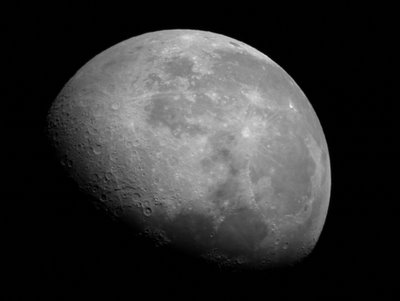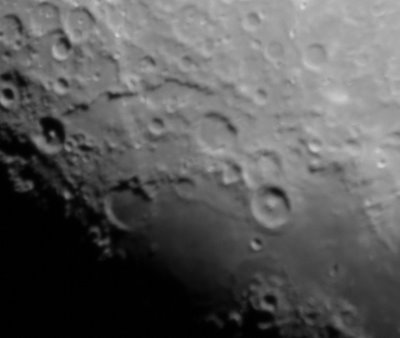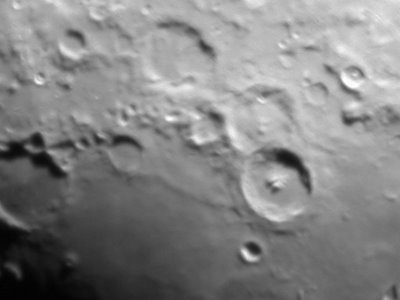Team TotL Assembles
 Kin set the camera up on the ground and snapped this photo where he caught a meteor in the background, seen behind the Tak. Image taken by Kin.
Kin set the camera up on the ground and snapped this photo where he caught a meteor in the background, seen behind the Tak. Image taken by Kin.Session name: 20061109.2045
This session was real fun, especially rebounding from the previous day where the Mercury Transit occurred behind downpours and clouds. This was the first time in a very long time, maybe a year, that the full team TotL assembled. Charlie, Kin, Ben, and myself set up with bins, refractors, and cameras at the Top of the Lawn. When I arrived about 8:30 ~ 8:45 the sky was clear but the air on the ground looked and felt silghtly damp. The wind was 10 ~ 15 mph early in the session finally easing up after midnight.
As for transparency and seeing, I recall looking to the Pleiades when it was high in the sky seeing all plus Asterope and Celaeno, I couldn't confidently say I saw Pleione. The Perseus Fishhook that hangs to the east of 39/delta Per consists of HR1207 (mV: 5.37), 48 Per (mV: 4.04), 51/mu Per (mV: 4.14), HR1324 (mV: 4.61) & 47/lambda Per (mV: 4.29). I could see all except the dimmest HR1207. I can't recall which double it was but Ben had an unequal double where the primary was yellowish an dthe fainter secondary was blue sitting just outside of a nice steady diffraction ring of the Airy Disk.
I looked at a couple of objects through all our optics and then got down to business with the Coolpix when Moon rose well above the trees. The dang Nikon MC-EU1 wired remote control is a pain in the arse, but when it is working it works well and I like it alot. Nothing short of voodoo gets this thing working and then avoiding conflict with a sensitive temperament like maybe waiting too long between pictures or impatiently trying to signal rapid picture taking causes an inrecoverable burp. Reboot, cross your fingers and chant the chant. By the night's end I had two good runs where I was able to trigger about 133 pictures.
The Nikon Coolpix 995 met the Takahashi refractor on its first light when familiarizing myself with the camera. I tried for sunspots with the setup picture here. Like a modern man, I'm trying to learn all this by not RTFM. It should be M's because there are quite a few manuals to read.
Charlie was giving me tips to test out with the camera like zooming all the way in to Digital 4x and then focus, setting the camera's focus to infinity (the mountain icon :* P).
One highlight of the night was when Tammy stopped by on her bicycle. She said she's passed by us in the past but never stopped. Tonight she did and was treated to starhops and binocular views. At one poitn I helped her find Pleiades in the bins by standing behind her and sighting the along the binocular tubes. With my wrists resting on hers, nudging the bins up and down, left and right, my head was right behind hers where I was smelling her hair. It's a kinky sidewalk astronomer thing. Tammy would eventually get to see the Pleiades, Hyades, Alpha Persei Association, and a meteor shot under Perseus.
Here are few photos shot last night. The only modifications to the original were cropping and reducing the image size from 2048x1536 pixels coming from the camera as fine. I have yet to handle on Registax4. I have a lot of drift in my photos because I don't have a motorized mount so I may have to take that into consideration. Dunno yet.
 19 day moon. Clear skies, seeing good, some mild breezes at times.
19 day moon. Clear skies, seeing good, some mild breezes at times.


<< Home